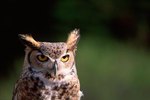
Zebras are fascinating animals, in large part because of their beautiful coats. Though the three species of zebras have their own basic patterns, no two zebras share the same stripe pattern. A zebra's stripes are as unique as our fingerprints and have an important role in their survival in the wild.
Species of Zebras
There are three species of zebras, each with its own unique pattern of stripes. Plains zebras have wide and widely spaced stripes. Mountain zebras sport smaller stripes that are spaced closely on the head and shoulders, and widely spaced on the haunches. Grevy's zebra has the narrowest, most closely spaced stripes as well as a white belly. Each type of zebra has the same basic pattern; however, each zebra's stripes are unique, much as our fingerprints are, so individual zebras can be identified easily.
Stripes as Camouflage
It's hard to imagine the eye-popping black and white stripes of a zebra could possibly help it blend into its landscape. However, they do just that, particularly in the dim light of an African night. Their stripes also conceal them in tall grasses, which is useful for hiding from predatory lions that can't distinguish colors. The stripes also may serve as a distraction to other animals who focus on the stripes instead of the shape of the animal. This very slight delay in understanding that there's a zebra there for the taking can give the fast zebra a head start.
Stripes as Identity
Young zebras are able to identify their mothers through their stripes. Also, adult zebras are able to recognize members of their own species through the pattern of the stripes. Zebras will flash their stripes at herd members when being chased by a predator as a signal to follow. This alerts the herd to danger and, as it starts to run, the predator often loses sight of its initial target in the overwhelming group of scrambling stripes.
Stripes as Insect Repellant
Horseflies, which love to feed on horses, would seem to be attracted to zebras. since zebras are related so closely to domestic horses. However, the zebra's coat actually may deter this insect from snacking on this particular brand of horse. Horseflies are attracted to polarized light, which mimics the water in which they lay their eggs. However, the zebra's black and white striped coat reflects light in alternatively polarized and non-polarized patterns, which makes it difficult for horseflies to pick out in its surroundings.
References
Photo Credits
-
Stockbyte/Stockbyte/Getty Images




